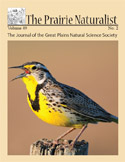Great Plains Natural Science Society

The Prairie Naturalist
Date of this Version
6-2015
Document Type
Article
Citation
The Prairie Naturalist 47:38–40; 2015
Abstract
Emerging infectious diseases (EID) present significant threats to the conservation of global biodiversity (Daszak et al. 2000). Evaluating impacts (spatial, temporal and demographic) of EIDs on sensitive and declining wildlife populations is challenging because quantitative information is usually dependent on estimates rather than counts (Wobeser 2007) and mortality rates are seldom quantified with conventional monitoring (Naugle et al. 2005).
West Nile virus (WNv), a mosquito-borne Flavivirus (family Flaviviridae; Komar 2001), was discovered in northwest Uganda in 1937 (Smithburn et al. 1940). First encountered in the western hemisphere in New York in 1999 (Nash et al. 2001), WNv has become enzootic in all 48 contiguous states, and has been reported from 96% of counties to date (Centers for Disease Control and Prevention [CDC] 2013). West Nile virus has been detected in 65 species of mosquito in the United States (CDC 2012) and its ability to establish and persist across ecosystems and hosts is illustrated by its extensive distribution (CDC 2013). West Nile virus infection has been reported in 326 avian species (CDC 2013). Among a more scarcely occurring avian guild like the raptors, the CDC Arbornet Surveillance System (1999 to 2004) have documented infection in 36 species (Nemeth et al. 2006), approximately 70% of all raptor species occurring in North America.
Included in
Biodiversity Commons, Botany Commons, Ecology and Evolutionary Biology Commons, Natural Resources and Conservation Commons, Systems Biology Commons, Weed Science Commons


Comments
Published by the Great Plains Natural Science Society. Used by permission.